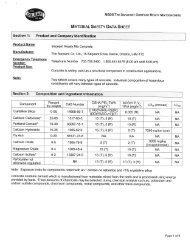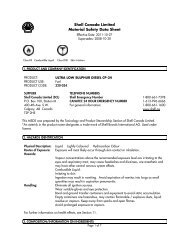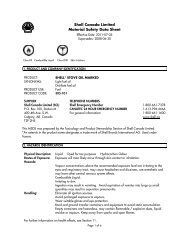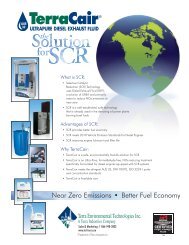Interseal 20G
Interseal 20G
Interseal 20G
Create successful ePaper yourself
Turn your PDF publications into a flip-book with our unique Google optimized e-Paper software.
and keep warm. Do not give anything by mouth to a convulsing or<br />
unconscious person.<br />
-INHALATION<br />
The main hazard following accidental ingestion is aspiration of the liquid<br />
into the lungs. If more than 2,0 mg/kg has been ingested, vomiting<br />
should be induced with supervision. If symptoms such as loss of gag<br />
reflex, convulsions, or unconsciousness occur before vomiting, gastric<br />
wash with a cuffed endotracheal tube should be considered. Cardiac<br />
arrhythmia has been reported with solvent exposure.<br />
5-FIRE AND EXPLOSION DATA<br />
-FLASH POINT<br />
-FLAMMABILITY LIMITS<br />
Upper<br />
Lower<br />
-EXTINGUISHING MEDIA<br />
-SPECIAL PROCEDURES<br />
-UNUSUAL FIRE AND<br />
EXPLOSION HAZARD<br />
-HAZARDOUS COMBUSTION<br />
PRODUCTS<br />
24 ° C min.<br />
7,0 (% by volume)<br />
1,1 (% by volume)<br />
Water fog, dry chemical, foam, carbon dioxide.<br />
Flammable. Vapors may travel along ground and flashback along vapor<br />
trail may occur. Do not use water except as a fog. Product will float and<br />
can be reignited on surface of water. Use water spray to cool fireexposed<br />
containers and structures. Always stay away from ends of<br />
containers due to explosive potential. Fight fire from maximum distance.<br />
Wear adequate protective clothing and an approved positive pressure<br />
self-contained breathing apparatus.<br />
Vapor forms an explosive mixture with air between upper and lower<br />
flammable limits. Sensitive to static discharge.<br />
Carbon monoxide and carbon dioxide.<br />
-N.F.P.A RATINGS Health: 2, Fire: 3, Reactivity: 0, Special Hazard: -<br />
6-ACCIDENTAL RELEASE MEASURES<br />
-CLEAN UP PROCEDURE<br />
-EVACUATION PROCEDURES<br />
-SPECIAL INSTRUCTION<br />
Try to work up wind of spill. Avoid direct contact with material. Saturated<br />
clothing should be immediately removed. Wear appropriate breathing<br />
apparatus and protective clothing. Stop leak only if safe to do so. Dike<br />
and contain land spills; contain water spills by booming. Use water fog to<br />
knock down vapors; contain run-off. For large spills, remove by<br />
mechanical means and place in containers. Absorb residue or small<br />
spills with absorbent material (sand or earth) and remove to non-leaking<br />
containers for disposal. Flush area with water to remove trace residue.<br />
Issue warning “Flammable”. Eliminate all sources of ignition. Isolate<br />
hazard area and restrict access.<br />
Notify appropriate environmental agency (ies).<br />
7-HANDLING AND STORAGE<br />
Avoid breathing vapors. Wear protective equipment during handling. Keep away from heat, sparks and open<br />
flame. Fixed equipment as well as transfer containers and equipment should be grounded to prevent<br />
accumulation of static charge. Store in a cool, well-ventilated area.<br />
2











